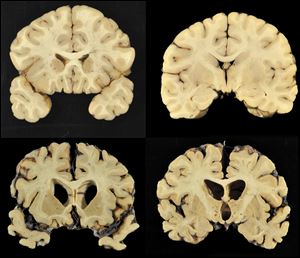
A breakthrough on CTE
4/12/2018
This combination of photos provided by Boston University shows sections from a normal brain, top, and from the brain of former University of Texas football player Greg Ploetz, bottom, in stage IV of chronic traumatic encephalopathy.
Away from the football fields and media attention, a Pittsburgh company has developed medicine it believes can treat the degenerative brain disease chronic traumatic encephalopathy, or CTE.
Noveome Biotherapeutics has created a nasal spray, to be administered during clinical trials later this year, which could treat CTE and other ailments, such as optic nerve damage.
RELATED: Company testing medication aimed at CTE
“We have a very, very safe product,” said William Golden, Noveome’s founder and CEO. “No adverse events.”
CTE, which was discovered by neuropathologist Bennet Omalu while working as a pathologist in the Allegheny County Coroner’s office in Pittsburgh, is a debilitating disease that creates behavioral issues, damages a person’s ability to think, and leaves them prone to mood swings. A considerable number of those found to have been afflicted by the illness have committed suicide.
CTE is still a disease largely defined by its mystery. At this point in time, a definitive CTE diagnosis can only be made posthumously and there are no approved treatments for it.
Because of these factors, Noveome’s medicine is likely to face challenges at its clinical trials. It may not be as effective as the company had hoped or perhaps it will be found that prescribing the medicine to someone who does not actually have CTE could have adverse effects.
Regardless of the outcome, however, it is a promising and important development that medical researchers are making substantive leaps in their ability to understand and treat CTE.
Click here to view more Blade editorials | Check out the Behind The Editorial series
CTE hangs over the sporting world like a dark cloud. The disease, which has been linked to contact sports like football, and even traditionally non-contact sports like baseball, has been the subject of much debate and analysis over the past several years. Much of that public conversation has centered around how football, and other sports like it, can endure, rather than how CTE can be diagnosed and treated effectively. The difficulties medical professionals have faced in deciphering the disease has limited the public’s ability to see a light on the other end of this terrible affliction. Noveome’s advancement has the potential to inspire new hope for those unwittingly suffering from CTE.
CTE affects the games we all enjoy, but, of far greater consequence, it also has has a direct and painful impact on the lives of those who suffer from it. It is not satisfactory to suspect someone may have CTE and then write them off as a lost cause. It is important that medical researchers continue to work to find causes, ways to diagnose the disease, and ways to treat it.
Noveome should be commended for its progress, but let’s not let it stop here.